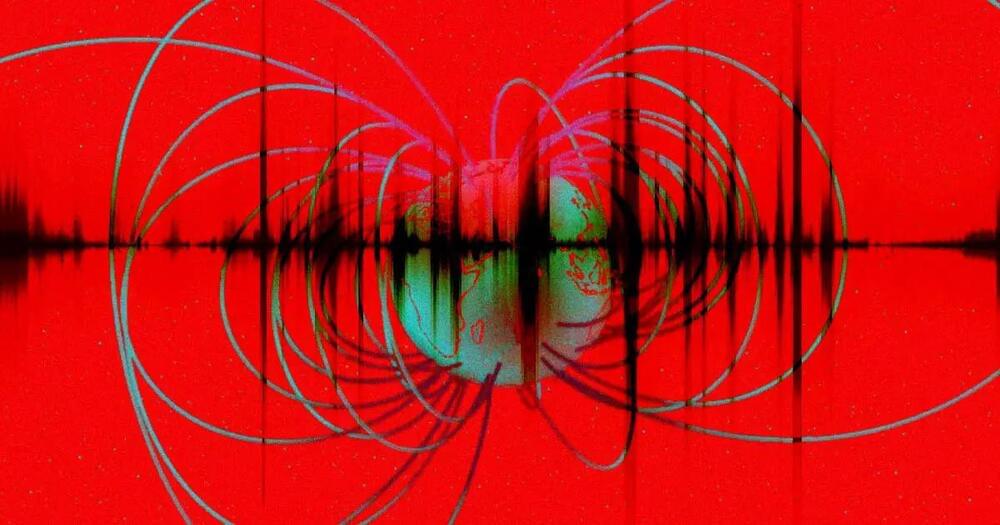Many of us think Musk is from another planet.
Caltech researchers have found evidence suggesting there may be a “Planet X” deep in the solar system.
Many of us think Musk is from another planet.
Caltech researchers have found evidence suggesting there may be a “Planet X” deep in the solar system.

Earth’s magnetic field dramatically flipped a little more than 40,000 years ago. We can now experience this upheaval as an unnerving clatter interpreted from information collected by the European Space Agency’s Swarm satellite mission.
Combining the satellite data with evidence of magnetic field line movements on Earth, European geoscientists mapped the so-called Laschamps event and represented it using natural noises like the creaking of wood and the crashing of colliding rocks.
Continue reading “Earth’s Flipping Magnetic Field Heard As Sound Is An Unforgettable Horror” »
The system that produced this outburst is referred to as CXOU J005245.0–722844. It was recently identified by members of the Einstein Probe team and confirmed by the Swift team as the seventh-known example of a Be/White Dwarf X-ray binary. Be/White Dwarf binaries are binary systems in which a white dwarf star orbits a hot young star surrounded by a disk of stellar material. Astronomers expect these binaries to be commonly observed, Gaudin said, and the lack of known examples is a mystery.
“Novae are explosions that happen when material from a nearby star is deposited onto the surface of a white dwarf,” Gaudin said. “After enough material has been built up, the surface undergoes rapid thermonuclear fusion which creates the outburst. Most novae are events that reach moderate luminosities and decay over the course of several weeks. This nova is strange not just in its extremely luminous behavior but also in its short duration.”
The thermonuclear reaction during the nova is similar to a massive hydrogen bomb exploding—the explosion produces electromagnetic radiation that can be seen by telescopes on Earth and in orbit around Earth. According to the researchers, the nova was visible at optical wavelengths, or visible light, for just under a week and in X-rays for just under two weeks.
The fabric of spacetime is four-dimensional, with three for space and only one for time. But wow, time sure is different from space!
“One option could be to have astronauts use this simulation to prepare for upcoming lunar exploration missions,” said Joe Louca.
How will future missions to the Moon help extract valuable resources that can be used for scientific research or lunar settlement infrastructure? This is what a recent study being presented this week at the IROS 2024 (IEEE/RSJ International Conference on Intelligent Robots and Systems) hopes to address as a team of researchers from the University of Bristol investigated how a combination of virtual simulations and robotic commands could help enhance teleoperated robotic exploration on the lunar surface on future missions.
For the study, the researchers used a method called model-mediated teleoperation (MMT) to create simulated regolith and send commands to a robot that carried out the task. In the end, the researchers found effectiveness and trustworthiness of the simulated regolith to the robot conducting the tasks was 100 percent and 92.5 percent, respectively. The reason teleoperated robots are essential is due to the time lag between the Earth and the Moon and extracting resources from the lunar surface, known as in-situ resource utilization (ISRU), is also being deemed an essential task at developing lunar infrastructure for future astronauts.
Continue reading “The Future of Lunar Resource Extraction: Teleoperation and Simulation” »
Ready to set another industry record!
New multi-launch agreement between Firefly Aerospace and True Anomaly includes three Alpha missions to provide rapid launch capabilities for Tactically Responsive Space mission sets
Cedar Park, Texas, October 17, 2024 – Firefly Aerospace, Inc., an end-to-end space transportation company, and space defense technology company True Anomaly, Inc., today announced a multi-launch agreement for three responsive launch missions aboard Firefly’s Alpha rocket. The first mission will deploy the True Anomaly Jackal Autonomous Orbital Vehicle (AOV) for the U.S. Space Force Space Systems Command’s VICTUS HAZE Tactically Responsive Space (TacRS) mission targeted for 2025. The two additional missions are available for execution between 2025 and 2027.

The Haven-1 project has an ambitious schedule, as its development and preparation for launch are planned to be completed in the second half of 2025. The Vast team includes experienced professionals, particularly former NASA astronaut Andrew Feistel, who provides advice on optimizing the module’s design.
“After three missions to space, we will use our experience to create a comfortable environment on the station. It is important to consider all aspects, from communications and private space to support crew work and scientific progress,” said Andrew Feistel.
Continue reading “ISS will be replaced by a space station with artificial gravity” »
Overlapping two 3D lattices with a relative twist opens the door to synthesizing crystals with diverse symmetries that showcase nontrivial band structures and novel properties.
When two identical periodic lattices overlap in space, with one twisted at an angle relative to the other, they form moiré lattices. The best-known examples are formed from stacked and rotated 2D sheets. These structures can possess fascinating properties not seen in their component layers. Twisted bilayer graphene, for example, can exhibit superconductor and Mott insulator behavior [1, 2]. Ce Wang of Tongji University in China and his colleagues now propose how to construct a 3D moiré lattice using two cubic optical lattices hosting ultracold atoms [3]. The researchers mathematically describe how two simple periodic structures, twisted relative to each other, can lead to 3D optical moiré patterns (Fig. 1). The result is a crystal-like structure with emergent properties that differ from those of the underlying simple lattices.

An exploration of Alien Invasions and Just Who Or What Can See us in the Galaxy for spooky season. My Patreon Page: https://www.patreon.com/johnmichaelgodierMy…
How did life on Earth begin, and were the ingredients for life already on Earth or were they brought here from space? This is what a recent study published in Science Advances hopes to address as a team of researchers from Imperial College London and the University of Cambridge investigated how ancient meteorites could have deposited large amounts of zinc on Earth, resulting in the development of volatile elements to form the building blocks of life. This study holds the potential to help researchers better understand the conditions for life to have emerged on the Earth long ago, and potentially worlds throughout the solar system and beyond.
“One of the most fundamental questions on the origin of life is where the materials we need for life to evolve came from,” said Dr. Rayssa Martins, who is a postdoctoral research associate at the University of Cambridge and lead author of the study. “If we can understand how these materials came to be on Earth, it might give us clues to how life originated here, and how it might emerge elsewhere.”
For the study, the researchers analyzed zinc obtained from several meteorites to ascertain how the Earth got its zinc during its formation, which is estimated to have lasted tens of millions of years. In the end, the researchers estimate that while “melted” planetesimals contributed to approximately 70 percent of the Earth’s overall mass, they only contributed approximately 10 percent of the Earth’s zinc, which came from “unmelted” planetesimals. As noted, zinc contains volatile elements, which include oxygen, nitrogen, hydrogen, and carbon, or the essential building blocks of life as we know it. Along with helping researchers better understand how life formed and evolved on Earth, this could also lead to greater insight into how life might form and evolve on other worlds, as well.